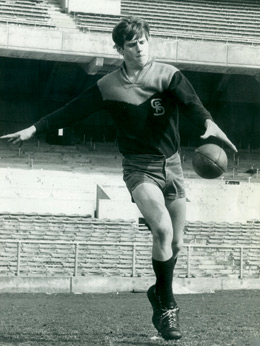|
HALL OF FAME INDUCTEE George Albert Young |
|
|---|---|
| Year Inducted | 2013 |
| Date of Birth | 3rd February 1949 |
Player 1969-1979
Games 195 (Subiaco 77, St Kilda 108, WA 10)
Goals 365 (Subiaco 72, St Kilda 284, WA 9)
Honours: All Australian 1972, St Kilda leading goalkicker 1975, 1976, 1977, 1978, Subiaco Team of the Century 2008, Subiaco Life Member 1992, Subiaco Diehard 2010
The term brilliant can be used rather too loosely with footballers but in the case of the superbly graceful and magnificent long left foot kicking wingman/half forward George Young, it is entirely appropriate. Besides being a delight to watch, Young had the rare ability to swing a match in minutes of brilliance and to lift for big games and he was seldom out of his team’s best in his 10 state appearances for WA which included the inaugural state of origin game in 1977.
Born in Caulfield, Melbourne but coming to WA with his family at 1 year of age, George Young was a football product of the Wembley amateurs and it was his brother Robbie who persuaded him to pitch up at Subiaco in 1969 looking for a game. After strong performances in scratch matches, Young played every league game bar one as a wingman of rare skill and poise. It was a personal triumph for a player who had more success at cricket than football as a teenager and who had had to overcome a kidney complaint that had hospitalised him for 4 months during those teenage years.
Playing every game in 1970, Young was selected for the state tour of Victoria and Tasmania and had the better of Francis Bourke on the wing in WA’s greatest ever performance on the MCG when they fell short by only 6 points. He was again named in WA’s best in both state games in 1971 and capped an outstanding interstate carnival series in 1972 with All Australian selection.
After attracting strong interest from Victorian talent scouts, Young was snared in 1973 by St Kilda for a reportedly large price tag. Cricket commitments delayed his arrival in Melbourne until mid March but he nevertheless made a spectacular debut on a half forward flank against Melbourne on the MCG kicking 4 classy goals. After damaging his knee in the opening quarter of the second round, Young missed 11 weeks but returned in time for the finals to confirm his status as a player of rare class. In the Elimination final against Essendon he gathered 25 kicks, took 14 marks and kicked 6 goals to elicit from one critic “In George Young’s liquid grace and lethal nonchalance, St Kilda fans saw the miracle of Baldock reincarnated”
After a difficult 1974 season, a bout of flu in 1975 saw Young’s career take another shift. After a couple of days in bed with a temperature he was placed at full forward rather than his usual half forward and responded by kicking 9 goals. “After each one I felt a bit better” he later explained. After another 8 goals the following week his position as spearhead was confirmed and George Young became St Kildas leading goalscorer each year from 1975 until 1978 when a knee injury finished his career. His many stunning performances included 10 goals against Fitzroy in a loss and 8 goals against Collingwood at Moorabbin.
Restricted by mumps in 1978, Young was rushed back for the crucial second last game against Collingwood but aggravated an old knee injury. It was the last of his 108 games for the Saints and he came back to Perth for an operation and with the intention of playing again for Subiaco. He did all the pre-season training in 1979 but the knee did not respond well and after a single game on 4th June 1979, a brilliant playing career ended.
Continuing his involvement with football, Young was a selector and runner with West Perth (1983-84) and Claremont (1985). From 1986 to 1992 he was a vital member of Haydn Bunton’s coaching panel at Subiaco as League Runner and Selector and the club played in 5 grand finals in this 7 year period. He was made a Life Member at Subiaco in 1992 and then gave 8 years of service to West Coast Eagles as a specialist coach and selector.
George Young was a gifted all round sportsman, scoring a century in his second Sheffield Shield game for WA but it is as a brilliant footballer in all conditions that he is best remembered. His remarkable ball handling and high marking in wet conditions were similar to the skills later displayed by Nicky Winmar and it is fitting that he should now join that wizard in the Western Australian Football Hall of Fame.



